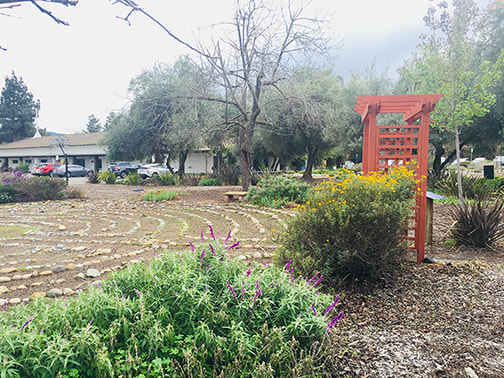|
by Susan Rowland

In our increasingly busy and complicated world finding time for quiet reflection is becoming necessary. Modern neuroscience has confirmed that meditative practices are healing for the traumatized or overworked brain.
What are the activities you engage in for refreshment, renewal, connection with your imagination and creativity? What are the practices you regularly engage in that enable you to stay connected to your truth, confidence, and assurance deepening your own spiritual life? Contemplative spiritual practices such as journaling, dream work, solitude and silence or lectio divina are some of the familiar ways of finding space to nourish and quiet the soul. The labyrinth is an additional practice that many people are experiencing as a way of rest and inspiration for weary hearts and minds. The labyrinth is often associated with medieval cathedrals; the most familiar Chartres Cathedral in France. This ancient walking meditation tool for prayerful reflection creates an opportunity to be a pilgrim – locally and without a lengthy investment of time. Unlike a maze, whose goal is to confound, confuse or entertain, a labyrinth has a single path leading to the center and back out with no dead ends or decisions required. This allows the mind and body to slow to its own natural rhythm. There is no right or wrong way to walk a labyrinth other than being respectful of those who are on the path with you. The recommendation is to experience it as a metaphor, inviting one’s imaginative ability to companion walking. In the larger sense, the labyrinth can be seen as a symbol for the unique journey within which each of us is a participant. It offers reflection on a daily journey that often has twists and turns.
The Contemplative Center of Silicon Valley at Westhope Presbyterian Church

It is important to connect with “your experience” as you walk, yet valuable to consider using a three-part process of Releasing, Receiving and Returning to facilitate your time.
As you begin your walk Releasing invites a slowing down of breathing, consciousness of your pace and attending to thoughts that arise. This may include the surrender of expectations for the walk, or calming a critical voice inquiring how this time will be useful, quieting concerns whether the walk is being done correctly. Pausing for a deep breath or placing a hand on the heart, perhaps a moment of prayer, one can relax. At times the labyrinth may have been entered with a question, concern or dream needing attention. Gently release the pressure for solution while mindfully holding it in thought or prayer. Receiving is often associated with arrival at the center. This is a time to linger, feeling free to stay as long as you like in whatever posture feels comfortable. Many times there is room to sit, kneel or stand tall with arms extended. This is a place to pray or deeply listen. Walking out of the center you will be Returning to the opening of the Labyrinth taking the same path. During this time it is helpful to consider how you will live out what you have thought or heard within. Perhaps a new project will have appeared or a deep sense of peace, strengthening or relaxation. Many have said “nothing happened,” but are aware in the next few days that a dream or inspiration materialized. It may be helpful to take a moment before leaving to sit quietly or record your thoughts in a journal. A common fear is that of getting lost. One of two things happen when one is lost on the path - either a return to the center or finding oneself at the beginning without having reached the center. Choices abound at this point. One can always redo the walk, but the holding of experience in metaphor may provide rich insight. What does being lost feel like? Is there anything that may be distracting you from your journey? Another concern is meeting others on the path. Holding your eyes with a “soft gaze” is helpful. The “soft gaze” is one used while holding a newborn or looking into the eyes of a loved one. A “hard gaze” is valuable when looking for a street sign or locating a canned good on the crowded grocery shelf. The “soft gaze” facilitates the ease of movement around one another, whether stepping to the side or pausing so one can walk around you. Should you find yourself walking with someone who is slower or faster than your pace, passing or pausing allows space for each to remain in a natural rhythm. The outdoor Labyrinth at Westhope Presbyterian Church is always available for your use. To find a labyrinth closer to you, check the website Veriditas.org by clicking on the Labyrinth Locator. Should you be interested in a private or group walk with a spiritual director, please email your inquiry to [email protected]. EMAIL US YOUR REFLECTIONS! We want to hear your response to what we post and we'll post comments of value for all of our readers. Comments are closed.
|
Archives
July 2024
|
